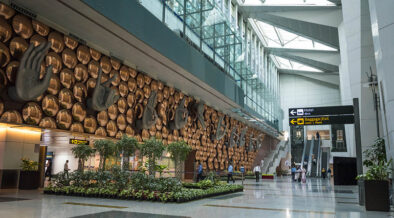
Joe Bates discovers more about the current growth trajectory of Delhi’s Indira Gandhi International Airport.
Delhi’s Indira Gandhi International Airport (DEL) is India’s busiest and best-connected gateway, handling close to 80 million passengers annually and non-stop services to 144 destinations across the globe.
Operated by GMR Airports Limited-led Delhi International Airport Limited (DIAL), last year’s total of 77.8 million passengers represented a (+7.8%) rise on 2023 and a healthy 15% increase over the 68.4 million accommodated in pre-COVID 2019.
International traffic increased by almost 17% in 2024, largely driven by extra services from Air India and IndiGo, and domestic passenger numbers by 5.5%.
DEL is also India’s leading cargo hub – accommodating just over one million tonnes of freight in its FY2024 – and a sustainability and customer service pioneer based on its impressive sustainability record and annual performance in ACI’s ASQ Airport Experience Awards, which is based on passenger feedback on the day of travel.
It has certainly come a long way since Delhi International Airport Limited (DIAL) assumed control of the airport in 2006 as it inherited a facility with a modest terminal capacity of just 12 million passengers per annum.
Since then, DIAL’s relentless focus on expansion and modernisation has propelled the airport to a remarkable milestone – a capacity of 100 million passengers per annum.
This transformation, culminating in the recent Phase 3A expansion, underscores Delhi’s ascent as a leading aviation hub, aligning with the vision of creating a “bigger, better, smarter, and future-ready” gateway for India.
TERMINAL 1: A CORNERSTONE OF GROWTH
Central to this evolution is the newly developed Terminal 1, unveiled as part of the Phase 3A expansion.
Designed to handle 40 million passengers annually, airport CEO, Videh Kumar Jaipuriar, has no doubt that it exemplifies DIAL’s commitment to capacity and quality.
Indeed, he believes that the terminal’s upgrades “go beyond scale and have redefined the passenger experience”.
For as well as raising DEL’s capacity, the new-look Terminal 1 has eased pressure on Terminals 2 and 3 and, according to Jaipuriar, ensured a “smoother travel experience with improved amenities and advanced technology”.
The upgrade has certainly delivered an enhanced boarding experience for passengers courtesy of 22 passenger boarding bridges (it previously had none) that have eliminated the inconvenience of bus transfers, offering direct aircraft access.

He notes that T1’s new streamlined check-in facilities include 100 check-in counters, including 36 self-baggage-drop kiosks, alongside high-tech, self-check-in machines and queue-busting mobile check-in options that have ensured quicker and easier airport journeys for passengers.
Baggage efficiency in the terminal has also been significantly improved by the use of ten 70-metre baggage reclaim carousels that have raised the terminal’s baggage handling capacity to 6,000 bags per hour.
While advanced technology such as cutting-edge scanners and intuitive systems are designed to minimise wait times, making the journey from check-in to departure – or arrival to baggage claim – smooth and more efficient.
Jaipuriar enthused: “These enhancements transform T1 into a passenger-centric hub, setting a new benchmark for efficiency and comfort in Indian aviation.”
EXPANDING BEYOND THE TERMINAL
DIAL’s vision for the future, of course, extends beyond the airport’s terminals to the airside infrastructure critical for a thriving hub.
The commissioning of a fourth runway, an eastern cross taxiway, and several rapid-exit taxiways have raised DEL’s airside capacity to potentially support up to 140 million passengers annually.
“These upgrades will enable smoother aircraft movements, reduce delays, and accommodate future traffic growth, positioning Delhi to compete with the world’s leading airports,” enthuses Jaipuriar.
“The Phase 3A expansion, with T1 as its centrepiece, is more than an infrastructure milestone – it’s a stepping stone toward establishing Delhi as a global aviation powerhouse.
“By blending scale, technology, and passenger-focused design, DIAL is not only meeting today’s demands but also paving the way for a future where India stands tall in the global aviation landscape.”
REFURBISHMENT OF TERMINAL 2 TO ESTABLISH GATEWAY AS AN INTERNATIONAL HUB
India’s hub strategy is set to revolutionise its aviation landscape by transforming select airports into international transit points, reducing dependency on foreign hubs like Dubai, Singapore, and Frankfurt for Indian travellers.
This ambitious plan, driven by the Ministry of Civil Aviation’s vision to make India a global aviation hub by 2047, hinges on three pillars: bolstering infrastructure; optimising connectivity; and fostering airline partnerships.
At the forefront of this transformation is Delhi’s Indira Gandhi International Airport, which DIAL believes exemplifies how a hub model can elevate India’s presence in global aviation.
And there’s more to come from DEL as earlier this year DIAL announced that Teminal 2 will temporarily close for four to five months to allow for work to start on its upgrade.
As part of its revamp, the decades-old terminal will undergo significant enhancements aimed at elevating the passenger experience and increasing the airport’s capacity to meet future growth demands.
“The refurbishment will modernise key areas of the terminal and surrounding infrastructure, ensuring that T2 remains a top-tier facility in the global aviation landscape, capable of accommodating the evolving needs of passengers and supporting the airport’s continued growth,” states the airport operator.
The refurbishment of Terminal 2 is part of DIAL’s commitment to creating a world-class hub for travellers across India and Southeast Asia.
The terminal and its associated apron have been serving passengers for over four decades, and with the rapid increase in air traffic, major upgrades are essential.

Jaipuriar, says: “We, at DIAL, are committed to enhancing the overall passenger experience by upgrading key infrastructure, improving operational efficiency, and elevating passenger comfort.”
Key highlights of the Refurbishment Plan for Terminal 2 include new passenger boarding bridges (PBB) upgrades; mechanical and electrical improvements; civil and infrastructure enhancements; new Flight Information Display Systems (FIDS) and signage; and airside and apron refurbishment.
When it comes to civil and infrastructure improvements, DIAL notes that the terminal’s aesthetics will be upgraded with modern ceilings, ‘smart’ washrooms and advanced flooring, while outside it is hoped that better road connectivity will improve passenger convenience.
In addition, new canopies at the forecourt will offer better protection to visitors from the weather, especially during hot summers and the monsoon season.
OVERCOMING HISTORICAL CHALLENGES
Across the country, historically, Indian airlines have struggled to compete on the international stage.
Putting this into perspective, Indian carriers have traditionally only captured 36% of the market for passengers travelling to or from India and just 1% of transit passengers travelling between two foreign destinations.
The far from ideal situation has led to Indian carriers and airports getting sidelined for international traffic flows as global competitors dominated on the often lucrative transit routes.
India’s hub strategy seeks to reverse this trend by consolidating domestic traffic from Tier-2 and Tier-3 cities and channelling it into international networks through key airports like Delhi. Jaipuriar notes that this not only boosts airline yields but also positions Delhi as a seamless transit point for both India-bound and international-to-international [I-I] passengers.
DELHI AS THE FLAGSHIP HUB
Delhi’s role as a hub goes beyond connecting India to the world – it is effectively a catalyst for economic progress and a symbol of resilience and ambition.
By linking smaller Indian cities to global destinations, says DIAL, the airport strengthens airline profitability and enhances passenger convenience.
Jaipuriar reveals that efforts are underway with the airlines to capture I-I traffic flows, with the ulitmate aim of strenghtening DEL’s hub status and leading “India’s ascent as a global aviation powerhouse, driving connectivity and prosperity across the region”.
SUSTAINABILITY CHAMPION
Indira Gandhi International Airport has long been a pioneer in the development and introduction of sustainable initiatives and solutions, effectively making it a green leader in Asia.
DEL, of course, became the first airport in Asia handling more than 40mppa to achieve net zero status for carbon emissions under its own control (Scope 1&2) in ACI’s Airport Carbon Accreditation programme (Level 5) in 2024.
It is now working with other stakeholders to reduce Scope 3 emissions, which comprise aircraft emissions, passenger access, emissions through GSEs, and others.
Some of the initiatives that have helped DEL achieve its lofty status in ACI’s Airport Carbon Accreditation programme include the 100% use of renewable energy, that has elimated 200,000 tonnes of CO2 annually; the use of taxibots to tow aircraft between gates and on the apron/airfield; and an all electric fleet of DIAL ground support vehicles.
DEL’s elevated Eastern Cross Taxiway commissioned as part of the recent Phase 3A expansion has reduced aircraft taxiing times, saving approximately 350kg of fuel per aircraft movement or 55,000 tons of CO2 annually.
The airport achieved LEED Platinum certification for its new Terminal 1 for adopting green construction methods, while its waste management efforts include the use of 350 rainwater harvesting systems and a zero liquid discharge sewage treatment plant.
Also worthy of note is the fact that 20% of its passengers currently use public transport (Metro and Bus) to reach DEL. The airport wants to increase this figure to 50% by 2030, leveraging the addition of new metro lines and APMs, which once again will significantly reduce the CO2 emissions associated with the gateway.

USING SCIENCE AND TECHNOLOGY TO ENHANCE OPERATIONAL EFFICIENCY AND PASSENGER EXPERIENCE
As India’s busiest airport, DEL has strategically adopted innovative solutions to address the challenges of rising traffic and evolving traveller expectations.
One key recent development is the implementation of AI-powered predictive analytics, which enhances resource allocation and operational planning.
The use of AI & ML at the Airport Operation Centre (APOC) for instance, allowed DIAL to reduce the security screening wait time for domestic passenger by up to 25%.
“On the terminal side, we have implemented AI-enabled, sensor-based passenger flow management software to visualise passenger flows and monitor queue length and wait times,” says Jaipuriar.
“In India, we were the first airport to implement facial recognition-based DigiYatra for efficient travel journeys. It enables contactless identity verification at entry and security points, cutting processing times and enhancing convenience.
“On the aiside; DIAL has recently launched the UTAM (Unified Total Airside Management) platform which helps to monitor aircraft turnarounds using computer vision to capture the movement of airside vehicles, and share automatic alerts to concerned teams for enhanced safety measures.”
NOIDA INTERNATIONAL AIRPORT
What impact, if any, does he believe the new airport will have on aviation in the Delhi region, and specifically, the future growth of DEL?
“The domestic Indian aviation market has grown at a compound annual growth rate [CAGR] of 8% to 9%, and in the future, the Indian market is likely to grow at a healthy rate of 8% to 10% over the next decade, and become one of the top three markets in world,” answers Jaipuriar.
“So, in the long-term, the India market/National Capital Region catchment will be big enough for both airports to grow.
“The catchment area for Delhi and Jewar, where Noida is located, are also different – hence Jewar would be a complementary airport to DEL as initially it would predominantly cater to its specific catchment areas across western Uttar Pradesh.
“In comparison, Indira Gandhi International Airport will continue to cater to Delhi, Gurgaon, Noida, Ghaziabad, and other neighbouring areas.
“With growing demand for intra-state connectivity/regional connectivity, Jewar can provide for the necessary demand for that segment.”






